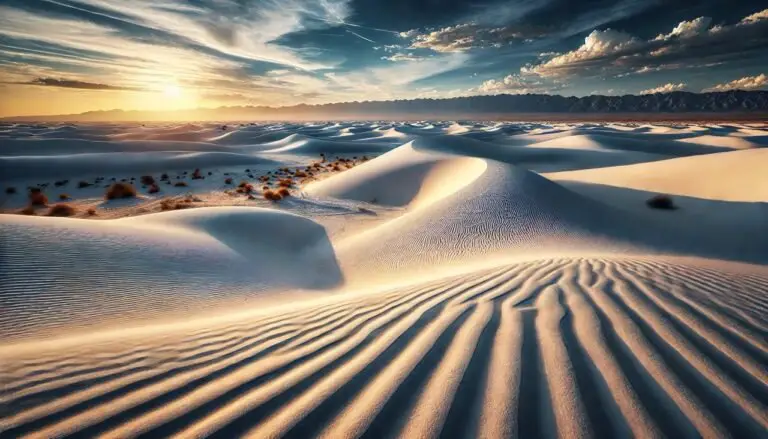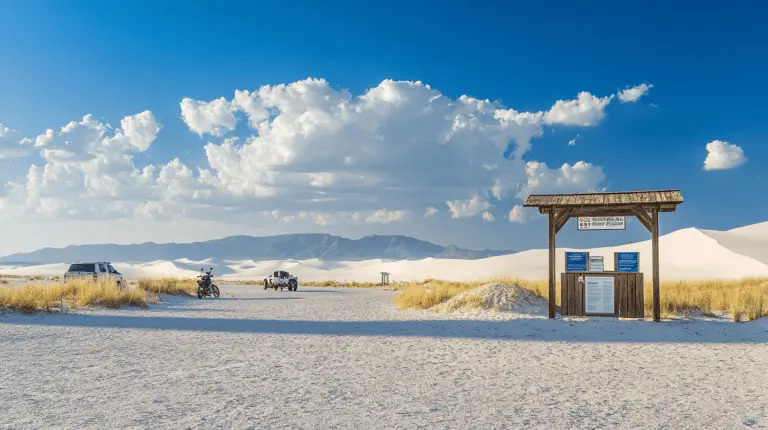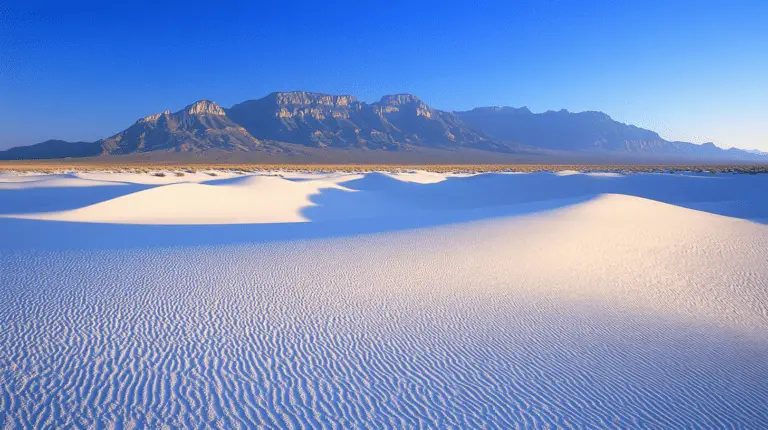White Sands National Park Location
White Sands National Park is a place that can take your breath away. With its shimmering white dunes and surreal vistas, it’s a must-see for any adventurer or nature lover.
Where Exactly Is This?
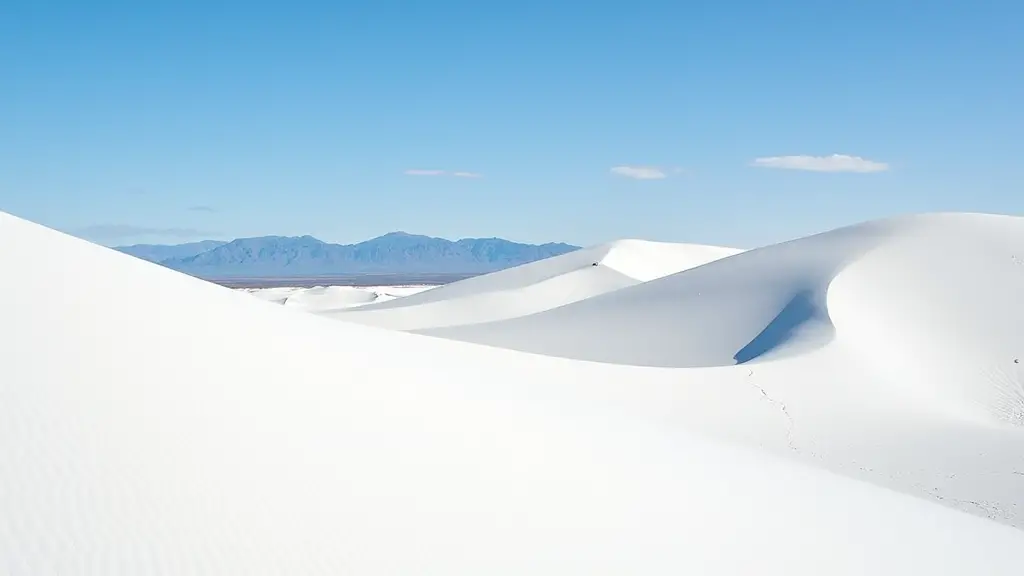
White Sands National Park sits comfy in south-central New Mexico, USA. Covering 275 square miles in the Tularosa Basin, it’s nestled between the San Andres Mountains to the west and the Sacramento Mountains to the east (Britannica). The closest city? That’d be Alamogordo, New Mexico, up northeast. A little further in the southwest corner is Las Cruces.
Surrounded by the White Sands Missile Range and with the Holloman Air Force Base nearby to the east, this park is securely tucked in one unique neighborhood.
| Quick Facts | Details |
|---|---|
| State | New Mexico |
| Nearest City | Alamogordo |
| Mountains | San Andres (West), Sacramento (East) |
| Area | 275 square miles (712 sq km) |
| Nearby Spots | White Sands Missile Range, Holloman AFB |
Want a better view of where you’re going? Check out the White Sands National Park Map.
Weather Check
Knowing what the weather’s like can make or break your trip. Think desert: hot summers, cold winters, and dry air almost all the time. Sunblock and layers are your best buds because it can be blazing hot during the day and chilly at night.
Here’s a snapshot of what each season typically feels like:
| Season | Average High (°F) | Average Low (°F) |
|---|---|---|
| Winter | 58 | 23 |
| Spring | 72 | 40 |
| Summer | 95 | 65 |
| Fall | 77 | 40 |
Got that? Great! Now be sure to stay updated with the weather on our White Sands National Park Weather page.
Heads up: Sometimes the park has to close because of missile testing nearby. Best to check park closure alerts before you go. For more on activities and safety, don’t miss out on our articles about White Sands Dunes and White Sands Hiking Trails.
Enjoy the wonder that is White Sands, and stay smart about the weather for the best trip ever!
Nearby City and Services
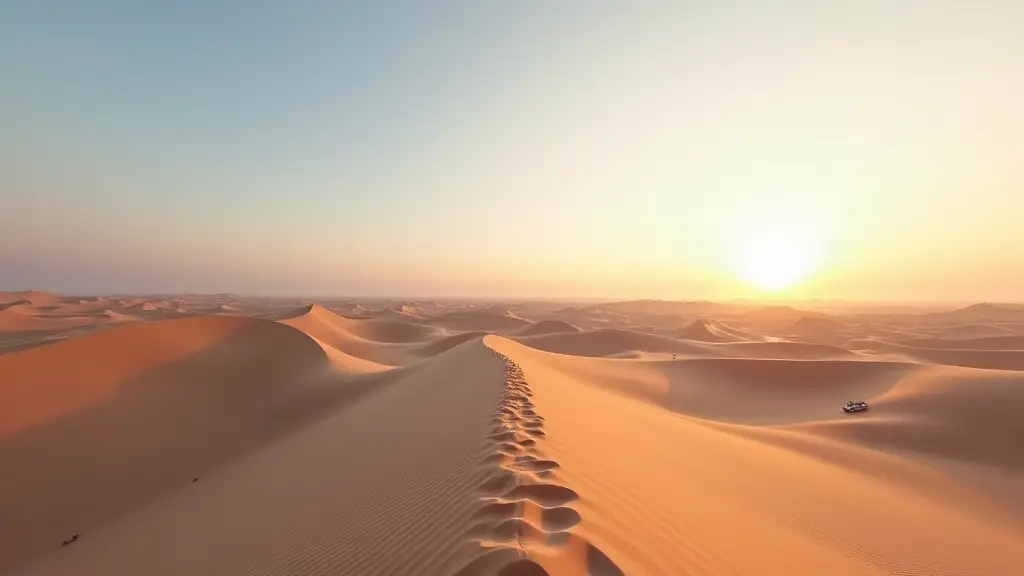
When you’re headed to the stunning White Sands National Park, knowing your options for nearby cities and services can make your trip smoother. Let’s break down the closest city and how to get there from major cities.
Alamogordo, New Mexico
Alamogordo, New Mexico, is your nearest city, just around 15 miles northeast of White Sands. This city covers all the essentials—places to stay, eat, shop, and more. Perfect for a quick pit stop or an overnight stay.
| Service | Available in Alamogordo |
|---|---|
| Accommodations | Hotels, Motels, B&Bs |
| Eats | Restaurants, Cafes, Fast Food Joints |
| Shopping | Supermarkets, Boutiques |
| Health Services | Hospitals, Clinics |
| Visitors’ Assistance | Tour Operators, Info Centers |
Want to get the most out of your visit? Alamogordo isn’t just a service hub; it’s got cool spots like the New Mexico Museum of Space History and Alameda Park Zoo. For more about what you can do around the park, check out our Alamogordo White Sands guide.
Getting There from Major Cities
White Sands National Park is a hop, skip, and jump away from several big cities, making it easy to plan your trip (Britannica).
| Major City | Distance to White Sands |
|---|---|
| Las Cruces, NM | 52 miles |
| El Paso, TX | 85 miles |
| Albuquerque, NM | 224 miles |
| Tucson, AZ | 296 miles |
| Phoenix, AZ | 419 miles |
These cities not only get you closer to White Sands but offer plenty of amenities and services for any pit stops you want to make along the way. Major airports in these cities make planning even easier. If you’re driving, take the scenic routes for a beautiful journey.
For more on travel logistics and visitor info, check out White Sands National Park Map and Visitor Center Details.
Research and Conservation Efforts
Getting a grasp on what makes White Sands National Park tick not only makes your visit cooler but also helps keep this one-of-a-kind spot in tip-top shape. Tons of research and conservation work are happening to protect its natural wonders.
Groundwater Study
Since 2009, White Sands has been digging (pun intended) into its groundwater with help from various institutions. Turns out, the water keeping the dunes alive is linked to the region’s groundwater table (National Park Service). This finding is like striking gold for park managers who need to figure out how water movement affects dune stability and the whole ecosystem. It’s a balancing act to keep the dunes looking sharp.
| Year | Groundwater Level (feet) |
|---|---|
| 2009 | 15 |
| 2012 | 13 |
| 2015 | 14 |
| 2018 | 13.5 |
| 2021 | 14 |
Dune Formation Research
Dr. Ryan Ewing from Texas A&M University uses cool gadgets like LiDAR and weather stations to study how dunes form and shift in the park. This geeky stuff helps us understand how new dunes pop up, their funky shapes, and how fast they move around (National Park Service). Predicting these changes is like having a crystal ball—super helpful for saving the dunes and keeping visitors safe.
Sedimentology Studies
Dr. Kathy Benison and her crew from West Virginia University are all about the sedimentology of White Sands’ modern lakes. Their research proves that gypsum keeps forming, adding material to mold the dunes (National Park Service). This ongoing gypsum production is a big deal for the park’s gypsum dunefield, the largest on the planet.
For tourists and nature buffs like you, knowing about these research efforts makes the park more than just a pretty place. You’ll feel more connected knowing the nitty-gritty of what shapes this amazing environment. Got the urge to dig deeper? Check out white sands national park geology for more about the park’s rocks, or peek at the park’s plants and animals pages for some juicy ecological details.
Geology and Ecology
Biggest Gypsum Dunefield Ever
Welcome to White Sands National Park, home to the planet’s largest gypsum dunefield. We’re talking about a whopping 275 square miles in the heart of New Mexico’s Tularosa Basin. Imagine a sea of blindingly white dunes rolling as far as the eye can see. These sands come from the coolest geological story, involving ancient lakes and crystal magic (dig deeper into the park’s geology).
| Feature | Measurement |
|---|---|
| Area | 275 square miles |
| Gypsum Content | 99% pure gypsum |
How These Dunes Came To Be
Creating these dazzling dunes isn’t just a one-time deal; it’s an ongoing nature show starring wind and water. Everything kicks off with limestone breaking down in the surrounding areas. When the region gets a good soaking from periodic floods, these waters gather in places like Lake Lucero and Alkali Flat. As the water evaporates, selenite crystals form. Once dried up, these crystals get smashed into tiny bits by the wind, starting the cycle anew every decade or so (all about the gypsum).
Sitting smack between the San Andres and Sacramento Mountains, the park gets hit by strong winds, which play the starring role in shaping these dunes.
Surprising Wildlife
Though it might look bare at first glance, White Sands is buzzing with a unique ecosystem. The plants and critters here aren’t just any plants and critters—they’ve adapted to thrive in this harsh, white desert. You’ll see some tough grasses and shrubs that hold the dunes together with their roots.
Critters have also gotten really clever about blending in. You’ve got light-colored mice and lizards that are masters of disguise against the bright sands. Birds, insects, and small mammals have also found their groove here, making the park’s ecosystem pretty diverse.
For more on the botanical and critter aspects of this park, head over to white sands plant life and white sands wildlife.
| Species | Cool Adapation |
|---|---|
| Mice | Light-colored fur for sneaky camouflage |
| Lizards | White scales to blend in perfectly |
| Plants | Deep roots to keep those dunes from wandering |
So, White Sands isn’t just a pretty face. It’s a giant outdoor classroom for geology and ecology nerds alike. From its formation to its wildlife, everything here offers a peek into how life adapts in extreme environments. And if you’re planning to visit, don’t forget to check out our visitor center deets and hiking trails. Trust me, you won’t regret soaking up every bit of this jaw-dropping natural wonder.
Visitor Info: Your Guide to White Sands National Park
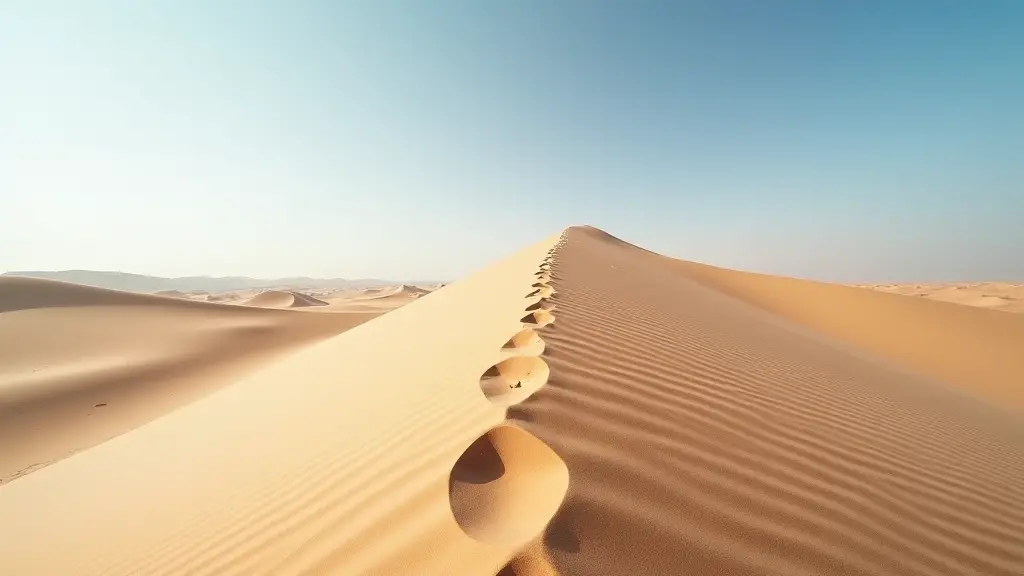
Heading out to White Sands National Park? You needn’t feel stressed, we’ve got some tips to keep your visit smooth and fun. Here’s the lowdown:
Stay Safe
Safety first, folks. Here are some quick tips to keep your visit worry-free:
- Water: Carry a good amount, especially when it’s warm. Trust us, you’ll need it.
- Sun Gear: Sunscreen, a hat, and sunglasses to protect from that intense reflection off the white sands.
- Weather Check: Always look at the weather forecast before you head out.
- Stick to Trails: Wander off-path, and you might lose your way in the dunes.
- Emergency Kit: A basic first aid kit can be a life-saver for those little mishaps.
Watch Out for Park Closures
White Sands might shut down parts, or the whole park, for missile testing. It’s close to the White Sands Missile Range. Save yourself the hassle and check for closures:
| Alert Type | How Often? | Notification |
|---|---|---|
| Missile Testing | Sometimes | Website Updates |
| Extreme Weather | Seasonally | Weather Alerts |
| Wildlife Hazards | Rarely | Visitor Center Announcements |
Get the latest updates on closures at park hours info.
Fun With Rangers
Amp up your visit by joining one of the cool ranger-led programs:
- Guided Hikes: Walk the hiking trails with a ranger who knows their stuff.
- Talks: Get schooled on the park’s history, rocks, and ecosystem.
- Stargazing: Take in the desert night sky with a guide.
- Interactive Fun: Try hands-on activities about the amazing gypsum dunes (white sands dunes).
Check out more details, schedules, and how to join in at park tours info.
Planning your trip to White Sands is a blast with plenty to see and enjoy. Stick with these tips, keep up with updates, and you’re set for a memorable and safe adventure. For more details, our full guide is at White Sands National Park info.
A Trip Through Time at White Sands
White Sands National Park isn’t just about stunning dunes and desert views. It’s also a place steeped in history. Here are some cool highlights:
Footprints from the Past
Imagine walking in the steps of ancient humans. At White Sands, archaeologists found footprints that are possibly the oldest in North America, dating back 21,000-23,000 years (Wikipedia). Yup, you read that right! These prints give us a snapshot of Paleo-Indian life. But it’s not just human tracks—ground sloths and Columbian mammoths left their mark here too. It’s like stepping into a prehistoric detective story!
| Discovery | Approximate Age |
|---|---|
| Human Footprints | 21,000 – 23,000 years |
| Ground Sloth Tracks | 10,000 – 12,000 years |
| Columbian Mammoth Tracks | 10,000 – 12,000 years |
From Monument to National Park
Once upon a time, in 1933, President Herbert Hoover made this place a national monument. Fast forward to 2019, Congress passed a law, signed by President Trump, turning it into a national park (Wikipedia). White Sands grew up, got a new name, and earned even more protection!
Traces of Giants

Walking around the park, you’ll find traces of giants like Columbian mammoths and ground sloths. These magnificent creatures roamed the land thousands of years ago, and their footprints are still here to tell their story. It’s like the ultimate ancient Instagram!
Got a thing for history? Dive into the details on our White Sands National Park history page.
White Sands National Park isn’t just eye candy; it’s like a living museum. You get a peek into the lives of early humans and now-extinct megafauna. Whether you’re geeking out over ancient tracks or soaking in the natural beauty, White Sands promises an unforgettable adventure.


